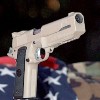TITAN308
Member
Have wanted for a while to model compensator after the H&K USP Match pistol that has long since been discontinued.
Originally the design was going to be for a Glock 17, but that has been gone a while so I am having my machine shop partners make one for my CZ75 Duty pistol. I just want it for fun at the range and to help my wife, but I am curious if there are certain types of pistol matches (open class?) that allow for these?
Does anyone use one of these on their night stand gun?
And now my master level artistic skills at work... :lol:


And for reference, the old H&K USP Match:

Originally the design was going to be for a Glock 17, but that has been gone a while so I am having my machine shop partners make one for my CZ75 Duty pistol. I just want it for fun at the range and to help my wife, but I am curious if there are certain types of pistol matches (open class?) that allow for these?
Does anyone use one of these on their night stand gun?
And now my master level artistic skills at work... :lol:


And for reference, the old H&K USP Match:









